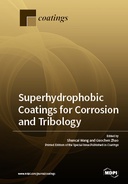Explore

Superhydrophobic Coatings for Corrosion and Tribology
Shuncai Wang and Guochen Zhao
2019
0 Ungluers have
Faved this Work
Login to Fave
Superhydrophobic surfaces, with a water contact angle >150°, have attracted both academic and industrial interest due to their wide range of applications, such as water proofing, anti-fogging, antifouling, anti-icing, fluidic drag reduction and anti-corrosion. Currently the majority of superhydrophobic coatings are created using organic chemicals with low surface energy. However, the lack of mechanical strength and heat resistance prevents the use of these coatings in harsh environments. Quality superhydrophobic coatings developed using inorganic materials are therefore highly sought after. Ceramics are of particular interest due to their high mechanical strength, heat and corrosion resistance. Such superhydrophobic coatings have recently been successfully fabricated using a variety of ceramics and different approaches, and have shown the improved wear and tribocorrosion resistance properties. This Special Issue focuses on the recent developments in the fabrication of superhydrophobic coatings and their robustness against corrosion and wear resistance, but the original work on other properties of superhydrophobic coatings are also welcome. In particular, the topics of interest include, but are not limited to: Robust superhydrophobic coatings; Coatings with super-wettability in multifunctional applications; Wetting effects on corrosion and tribology; Hierarchical Coating for wetting and modelling.
This book is included in DOAB.
Why read this book? Have your say.
You must be logged in to comment.
Rights Information
Are you the author or publisher of this work? If so, you can claim it as yours by registering as an Unglue.it rights holder.Downloads
This work has been downloaded 272 times via unglue.it ebook links.
- 29 - pdf (CC BY-NC-ND) at Unglue.it.
Keywords
- Al2O3-coated particles
- aluminum alloy
- Anodization
- carbon steel
- chemical etching
- chemical stability
- Corrosion Protection
- corrosion resistance
- Co–Ni coating
- damped harmonic oscillation
- dynamic characteristics
- electrochemical deposition
- electrochemical surface engineering
- electrodeposition
- electroless composite coating
- empirical formula of friction coefficient
- Etching
- ferrofluid drop
- friction and wear behaviour
- HVOF
- hydrophobicity
- low friction
- lubrication performance
- magnetic field
- mechanical durability
- micro-arc oxidation
- MoS2 particles
- n/a
- nanocomposite
- Ni–Co
- oil-water separation
- parabolic morphology
- rough morphology
- self-cleaning
- Stability
- super-hydrophobic coating
- super-hydrophobic surface
- superhydrophobic
- superhydrophobic materials
- superhydrophobic surface
- surface topography
- surfactant
- suspension
- thermal spray
- TiO2
- truncated cone morphology
- water-lubricated bearing
- water-repellent surfaces
- wear resistance
- WS2
Links
DOI: 10.3390/books978-3-03921-785-4Editions


